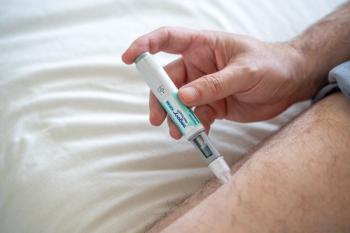
Pediatric ER Readiness: Where Do Pharmacists Fit in?
How can pharmacists be incorporated into pediatric readiness of emergency departments?
A version of this article first appeared on the author's blog, Emergency Medicine PharmD.
A new study published online ahead of print in JAMA Pediatrics has been making the rounds through major media outlets.1
The investigators of this study aimed to assess the readiness of emergency departments (EDs) across the United States in the provision of care to pediatric patients. This was based on the joint policy statement put forth by the American Academy of Pediatrics (AAP) related to guidelines for the care of children in the ED.2 Another evaluated area included the influence of pediatric emergency care coordinators, positions primarily held by physicians and nurses.
With a relatively high response rate of nearly 83%, representing 24 million pediatric visits to the ED on an annual basis, most ED representatives indicated a reported median weighted pediatric readiness score of 68.9 at the time the 55-question assessment was completed in 2013. This was an increase from a median weighted pediatric readiness score of 55 when a similar analysis was conducted a decade earlier in 2003.
Not surprisingly, EDs caring for a larger volume of pediatric patients had higher median scores than those with lower volumes (89.8 versus 61.4 [p <0.001]).
The assessment included the existence and provider type for the position of pediatric emergency care coordinators; specialty areas of board certification and/or training of providers; competencies; policies, processes, and procedures in place, such as quality improvement, weight measurements, equipment, mental health plans, and disaster plans; and the level of readiness in each of these categories as it related to the care of pediatric patients.
However, one particular area was not addressed in this study. That actually struck a cord with me and led me to ponder a bit. In fact, a colleague of mine even asked for my thoughts related to this particular area, which prompted me to write about this topic.
The question that came to me is: how can pharmacists and the provision of their services and clinical expertise be incorporated into pediatric readiness of EDs?
To the investigators' credit, they do note that, as it relates to weighing pediatric patients, an estimated one-third of those who responded to the assessment indicated that ED providers record patient weights in units of kg only, which has been widely recognized as a safety initiative in the prevention of errors related to drug dosing.3
But there is so much more to the story. In 2006, the Institute of Medicine put forth recommendations for improving the care of pediatric patients in the ED, and one of those recommendations included the development of appropriate formulations, dosage and labeling guidelines, and techniques for administration of medications in effort to maximize effectiveness and safety for pediatric patients in the ED.4 And, in the AAP joint policy statement, there is brief mention of ensuring dosage formulations and concentrations of medications are suitable for the pediatric population.2
There are various areas where pharmacists can become involved in pediatric readiness of EDs, and by no means is this an all-inclusive list:
- Gaining support for integration from key stakeholders of the ED as it relates to pharmacy-based needs for pediatric patients of the department and targeted areas for improvement over both the short and long terms.
- Attaining certification for responding to pediatric emergencies and resuscitations (e.g. pediatric advanced life support).5
- Developing dosing guidelines and concentrations of common oral and parenteral medications used in the pediatric population, which may extend to: Dilution strategies for developing various concentrations of oral and parenteral medications. Bedside dosing tables for calculating doses and volumes necessary for administration of medications, especially in the setting of volume limitations in this population.6
- Developing effective standards in order for the preparation and labeling of medications to occur in a safe manner.
- Recognition of various diseases states and associated complications that may lead to visits to the ED in the pediatric population.
- Recognition of off-label uses of medications commonly used in the pediatric ED.7
- Recognition of adverse effects associated with medications in general.8
- Involvement in education and training of physicians, mid-level providers residents, and nurses in areas related to clinical pharmacology and dosing calculations associated with pediatric resuscitation and toxicological emergencies.9,10
- Involvement in education and training of fellow pharmacists, pharmacy technicians, and pharmacists-in-training (e.g. students) in various competencies associated with drug delivery and monitoring in the pediatric population in the ED.11
- Ensuring outpatient prescriptions for medications are prescribed using appropriate standards and units of measurement prior to discharge with counseling provided to the patient and/or caregiver.12,13
While seemingly small and often underaddressed, these elements form a key piece of the puzzle as it relates to pediatric readiness in the ED. With these elements, providers in EDs will be equipped with the tools necessary for enhancing their readiness when it comes to the delivery of skilled and expert care to pediatric patients.
References:
- Gausche-Hill M, Ely M, Schmuhl P, et al. A National Assessment of Pediatric Readiness of Emergency Departments. JAMA Pediatr 2015 April 13 [Epub ahead of print].
- Joint Policy Statement: Guidelines for Care of Children in the Emergency Department. Pediatrics 2009; 124:1233-1243.
- Alessandrini EA, Knapp J. Measuring Quality in Pediatric Emergency Care. Clin Pediatr Emerg Med 2014; 12:102-112.
- Committee on the Future of Emergency Care in the United States Health System; Board on Health Care Services; Institute of Medicine. Emergency Care for Children: Growing Pains.Washington, DC: National Academy Press; 2007.
- Eppert HD, Reznek AJ. ASHP Guidelines on Emergency Medicine Pharmacist Services. Am J Health Syst Pharm 2011; 68:e81-95.
- Campbell MM, Taeubel MA, Kraus DM. Updated Bedside Charts for Calculating Pediatric Doses of Emergency Medications. Am J Hosp Pharm 1994; 51:2147-2152.
- Phan H, Leder M, Fishley M, et al. Off-Label and Unlicensed Medication Use and Associated Adverse Drug Events in a Pediatric Emergency Department. Pediatr Emerg Care 2010; 26:424-430.
- Zed PJ, Black KJ, Fitzpatrick EA, et al. Medication-Related Emergency Department Visits in Pediatrics: A Prospective Observational Study. Pediatrics 2015; 135:435-443.
- Kraus DM, Stifter J, Hatoum HT. Program to Improve Nurses' Knowledge of Pediatric Emergency Medications. Am J Hosp Pharm 1991; 48:97-101.
- Porter E, Barcega B, Kim TY. Analysis of Medication Errors in Simulated Pediatric Resuscitations by Residents. West J Emerg Med 2014; 15:486-490.
- Small L, Schuman A, Reiter PD. Training Program for Pharmacists in Pediatric Emergencies. Am J Health Syst Pharm 2008; 65:649-654.
- Wingert WA, Chan LS, Stewart K, et al. A Study of the Quality of Prescriptions Issued in a Busy Pediatric Emergency Room. Public Health Rep 1975; 90:402-408.
- Committee on Drugs. Metric Units and the Preferred Dosing of Orally Administered Liquid Medications. Pediatrics 2015; 135:784-787.
Newsletter
Stay informed on drug updates, treatment guidelines, and pharmacy practice trends—subscribe to Pharmacy Times for weekly clinical insights.













































































































































































































